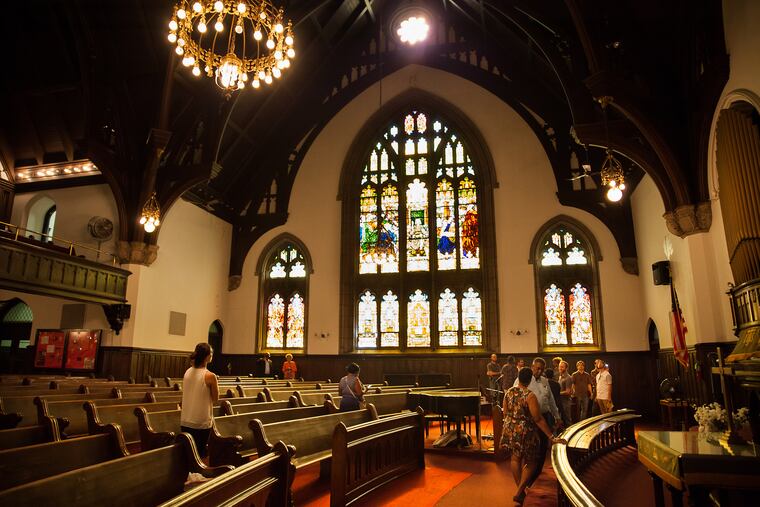How saving Philly’s historic sacred spaces can make the city stronger | Opinion
A new partnership hopes to create national prototypes that demonstrate the civic value of sacred places.

Wharton-Wesley United Methodist Church has been part of the residential fabric of the Cobbs Creek community since it was built in 1905. Its gray stone walls rise high above the neighborhood, its majestic stained-glass windows stir the soul.
Over the years, though, the world has changed dramatically, impacting the church’s size and resources. Once a congregation of 700, Wharton-Wesley now has a membership of 150. These days, most congregants live outside the neighborhood and want to put less into capital and more into church mission and outreach.
The challenge is figuring a way to survive, a challenge faced by thousands of congregations across Philadelphia and the nation. In many cities and towns, a third or more of the historic sacred places are at risk of closing in the next 10 to 20 years unless new uses and new resources can be found. Losing these neighborhood anchors threatens the communities in which they sit, many of them low-income and disadvantaged.
Enter “Infill Philadelphia: Sacred Places/Civic Spaces,” the exciting new partnership between Partners for Sacred Places and the Community Design Collaborative. Its purpose is to generate innovative design concepts and solutions for the re-activation of underutilized spaces in local historic sacred places.
Wharton-Wesley is one of three religious institutions that has partnered with local non-profits – in this case,ACHIEVEability, an organization that helps low-income and homeless families in the Haddington and Cobbs Creek areas. Together, they are working with a design partner, Brawer & Hauptman, Architects, on changes to reconfigure the church’s spaces to more efficiently serve the community and thereby make the building’s future brighter.
Also involved in the Infill project is the Philadelphia Masjid/Sister Clara Muhammad School, housed in the former St. Thomas More High School at 47th Street and Wyalusing Avenue in West Philadelphia. Masjid, already a center for Muslim culture in the area, is working with the People’s Emergency Center and design partner HOK. Masjid envisions using its classrooms for workforce training programs and sees the potential for redevelopment of the vacant schoolyard for affordable, multi-generational housing.
The third sacred place is the original building of the legendary Zion Baptist Church at 3600 N. Broad St. in Nicetown-Tioga. It is working with Called to Serve CDC and design partner Studio 6mm to imagine ways to use the space to help revitalize the community’s commercial corridor.
The goal of the Infill “design challenge,” which will reveal its final design concepts in December, is to create national prototypes that demonstrate the civic value of sacred places. That in turn may help generate new resources to help sustain religious buildings and support the communities that surround them.
This project is a direct challenge to the notion that sale and subsequent adaptive reuse or demolition are the only options facing declining urban congregations.
Sacred Places/Civic Spaces is the seventh installment of the collaborative’s Infill Philadelphia, an initiative to re-envision neighborhoods and rethink the use of older spaces that has addressed topics ranging from food access to affordable housing. And Partners for Sacred Places has been working since 1989 to preserve religious buildings. But this particular project has a special urgency for both organizations, and for the city at large: According to a Pew survey in 2016, there are 839 historic sacred places in Philadelphia. Many face maintenance challenges, shrinking resources, declining memberships, and, in some cases, development pressure.
Beyond their religious benefits and architectural beauty, these buildings are true civic assets. Most sacred places already provide public meeting space as well as room for community organizations that support the performing arts. They are trusted entities that house programs ranging from substance abuse groups to after-school programs, crossing denominational, racial, and regional lines. Studies also show that nearly 90 percent of the people served in these buildings are not connected to the congregations housed in them.
Recent research has allowed us to quantify the economic “halo effect” of sacred places by documenting the dollar value of social services and cultural programs sponsored by congregations. These include the value of clergy, staff, and volunteer time; space provided; in-kind support; and the environmental and public health value of outdoor open space, recreational facilities, parking lots, gardens, etc.
Add to that the impact of congregational spending (both operational budgets and capital projects) on local jobs and businesses, as well as the value of sacred places as gathering places and convening locations. Taken together, congregations in urban settings have an average annual economic impact of $1.7 million.
Sacred places constitute an irreplaceable community asset. With initiatives like “Sacred Places/Civic Spaces,” they can do much, much more to make our cities livable and economically healthy–for all.
Robert Jaeger is president of Partners for Sacred Places. Beth Miller is executive director of the Community Design Collaborative, a Philadelphia-based nonprofit that strengthens neighborhoods through design.